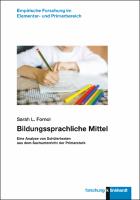Bildungssprachliche Mittel
Eine Analyse von Schülertexten aus dem Sachunterricht der Primarstufe
| dc.contributor.author | Fornol, Sarah L. | |
| dc.date.accessioned | 2021-11-12T09:57:07Z | |
| dc.date.available | 2021-11-12T09:57:07Z | |
| dc.date.issued | 2020 | |
| dc.identifier | OCN: 1290614264 | |
| dc.identifier.uri | https://library.oapen.org/handle/20.500.12657/51446 | |
| dc.description.abstract | The aim of the present study is to identify educational language devices that primary school pupils produce within non-fiction texts and to examine them with regard to their form-function relationship within non-fiction texts. The study is based on 474 texts written by learners in the second to fourth grades. In order to correspond to the complexity of the object of research, all 474 texts were first examined for the realisation of educational language devices by means of a cross-method triangulation with sequential design with the help of a quantitative frequency analysis on the basis of a deductively developed category system. Subsequently, a partial corpus (n=28) of the data material was selected by means of interleaved sampling and a content-structuring qualitative content analysis was carried out on the basis of a deductively-inductively developed category system in order to relate the educational language devices back to their function. The results of the study complement the findings of previous studies and provide important indications for future research into the means and skills of the language of education. At the same time, the findings enable conclusions to be drawn for the design of language-sensitive subject teaching. | en_US |
| dc.language | German | en_US |
| dc.relation.ispartofseries | Empirische Forschung im Elementar- und Primarbereich | en_US |
| dc.subject.classification | thema EDItEUR::J Society and Social Sciences::JN Education::JNC Educational psychology | en_US |
| dc.subject.classification | thema EDItEUR::J Society and Social Sciences::JN Education::JNL Schools and pre-schools::JNLB Primary and middle schools | en_US |
| dc.subject.other | Sachunterricht; Bildungssprache; Schülertext; Textanalyse; Primarbereich; Grundschulpädagogik; Sprachfertigkeit; Sprachkompetenz; Schuljahr 02; Schuljahr 03; Schuljahr 04; Sprachgebrauch; Sprachform; Sprachfunktion; Korrelation; Soziokultureller Faktor; Schulerfolg; Unterrichtssprache; Wortschatz; Soziolinguistik; Linguistik; Psycholinguistik; Studie; Triangulation; Quantitative Analyse; Qualitative Analyse; Stichprobe; Instruction in natural science subjects; Primary school science and social studies; Text analysis; Textual analysis; Primary education; Primary level; Primary school education; Primary school pedagogics; Language skills; Speech Skills; Language skill; Linguistic Competence; School year 02; School year 03; School year 04; Language usage; Correlation; School success; Success at school; Teaching language; Vocabulary; Sociolinguistics; Linguistics; Psycholinguistics; Qualitative analysis; Applied linguistics | en_US |
| dc.title | Bildungssprachliche Mittel | en_US |
| dc.title.alternative | Eine Analyse von Schülertexten aus dem Sachunterricht der Primarstufe | en_US |
| dc.type | book | |
| oapen.abstract.otherlanguage | Ziel der vorliegenden Studie ist es, bildungssprachliche Mittel, die Grundschüler/-innen innerhalb von Sachunterrichtstexten produzieren, zu identifizieren und diese hinsichtlich ihres Form-Funktions-Zusammenhangs innerhalb von Sachtexten zu untersuchen. Datengrundlage der Studie stellen 474 Texte von Lernenden der zweiten bis vierten Jahrgangsstufe dar. Um der Komplexität des Forschungsgegenstands zu entsprechen, wurden mittels einer methodenübergreifenden Triangulation mit sequentiellem Design zunächst alle 474 Texte mit Hilfe einer quantitativen Frequenzanalyse auf Grundlage eines deduktiv entwickelten Kategoriensystems auf die Realisierung bildungssprachlicher Mittel hin untersucht. Nachfolgend wurde mittels verschränktem Sampling ein Teilkorpus (n=28) des Datenmaterials ausgewählt und eine inhaltlich strukturierende qualitative Inhaltsanalyse auf Grundlage eines deduktiv-induktiv entwickelten Kategoriensystems durchgeführt, um die bildungssprachlichen Mittel auf ihre Funktion zurück zu beziehen. Die Ergebnisse der Untersuchung ergänzen die Befunde bisheriger Studien und liefern bedeutsame Hinweise für die zukünftige Erforschung bildungssprachlicher Mittel bzw. bildungssprachlicher Fähigkeiten. Gleichzeitig ermöglichen die Befunde Rückschlüsse für die Gestaltung eines sprachsensiblen Fachunterrichts. (DIPF/Orig.) | en_US |
| oapen.identifier.doi | 10.25656/01:18413 | en_US |
| oapen.relation.isPublishedBy | 9a084ee3-3f86-4be2-81d6-89c9fbc5f173 | en_US |
| oapen.relation.isbn | 9783781557925 | en_US |
| oapen.series.number | 6 | en_US |
| oapen.pages | 339 | en_US |
| oapen.place.publication | Bad Heilbrunn | en_US |

